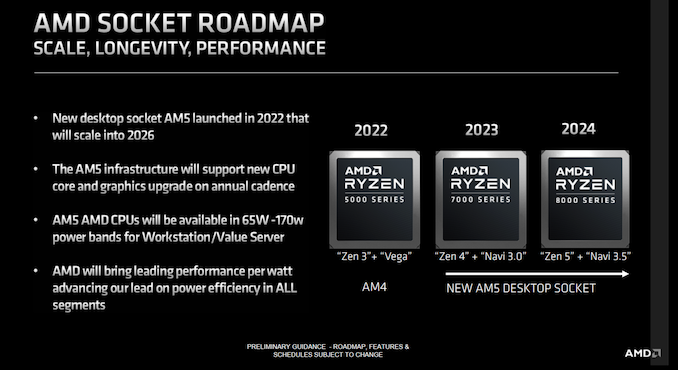Throughout among their webinars to transport partners on optimizing server implementations with AMD Ryzen processors, AMD revealed a few of the upcoming strategies surrounding their next-generation Zen 5 microarchitecture. Although we understand the wider AMD desktop roadmap up till 2025 and their strategies to introduce Zen 5, codenamed ‘Granite Ridge’ at some point in 2024, AMD has actually produced a somewhat upgraded roadmap. Within this roadmap is information revealing that their AM5 platform will formally support approaching Zen 5 processors.
On top of this, AMD has actually revealed that the Zen 5 desktop processors will fall under the Ryzen 8000 series household, however with a twist, as Zen 5 will likewise include a brand-new iGPU codenamed ‘Navi 3.5.’ The last of the possible statements is that we might see Ryzen 7000 series processors with RDNA 3 (Navi 3x) based integrated graphics later on this year.
Regardless of there being little technical details from AMD on their approaching Zen 5 (Granite Ridge) based processors, which are arranged for at some point in 2024, AMD has let the feline out of the bag. This consists of a number of considerable (albeit stealthily concealed) verifications about its next-generation platform. The very first of these verifications is that AMD’s Zen 5 for desktop items will come under the Ryzen 8000 series, the direct follower to AMD’s existing Zen 4-based Ryzen 7000 series for desktops.
AMD’s Ryzen 8000 desktop household of processors, as we now understand it to be, will include 3 main lineups. This consists of the routine desktop CPUs and a minimum of one however possibly more Zen 5-based processors with 3D V-Cache product packaging. The 3rd is a lower powered, lower specification, and more compact core called the Zen 5c series, which we understand from the case of Zen 4c, is utilized in AMD’s EYPC 128-core Bergamo processor
On top of the Ryzen 8000 calling verification, AMD has likewise revealed that their existing AM5 platform for motherboards will likewise support the approaching Zen 5-based processors which the AM5 socket will scale into 2026; AMD’s motherboards sockets for generations have actually had durations of durability and stability with brand-new processor launches, and AM5 seems no various in this regard. This indicates users with Ryzen 7000 and AM5-based motherboards such as X670E and B650E might in theory drop the upcoming Ryzen 8000 chips directly into the socket and make it possible for usage through a firmware upgrade. AMD, nevertheless, hasn’t validated this since yet.
The other fascinating disclosure is that AMD’s Ryzen 8000 series will not include RNDA 3-based incorporated graphics however with a brand-new codename that insinuates an upgrade to their existing Navi 3 items is likewise in the pipeline. This is called Navi 3.5, and although there are no main information on what AMD GPU architecture they will be based upon, or the requirements, we need to learn more on this closer to Zen 5’s launch, which, once again, is arranged for 2024.
The most considerable function of AMD’s somewhat upgraded roadmap is that it reveals AMD Ryzen 7000 series (Zen 4) processors with Navi 3.0 graphics. Considered that AMD’s presently launched Ryzen 7000 series processors, such as the Ryzen 9 7950X, have an RDNA 2-based integrated graphics chip (Navi 2x), this might be the most obvious disclosure yet from AMD that Ryzen 7000-based ‘APUs,’ a term which AMD has actually apparently proceeded from, might be launched later on this year. There is likewise an opportunity this might be a blooper in AMD’s roadmap.
Still, it stays to be seen whether we get a Zen 4-based SoC with better-integrated graphics that we have actually been accustomed to from previous generations of Ryzen processors.
